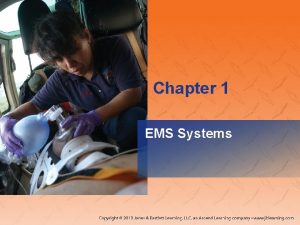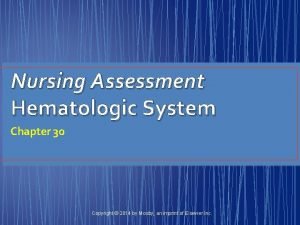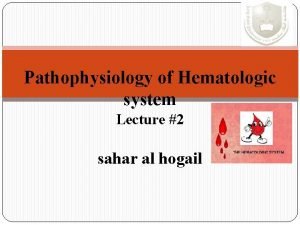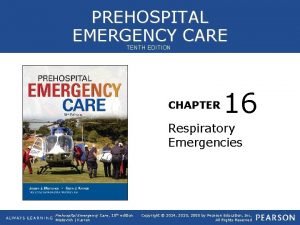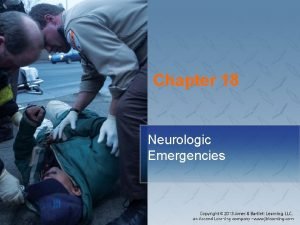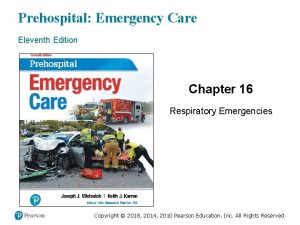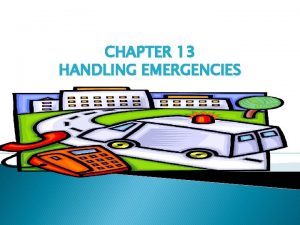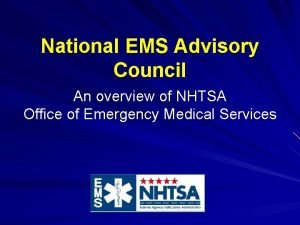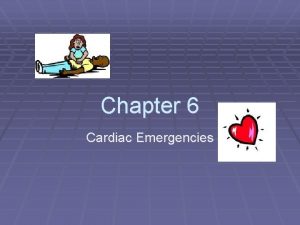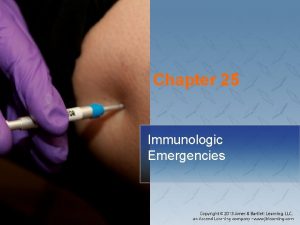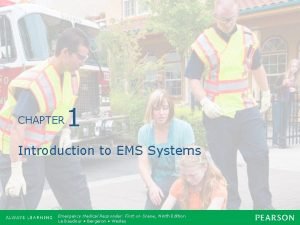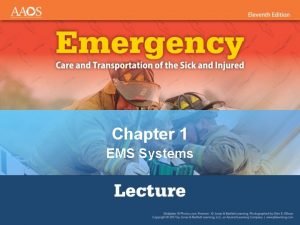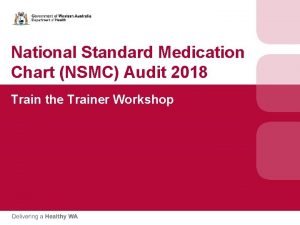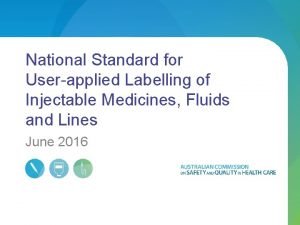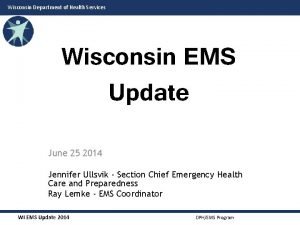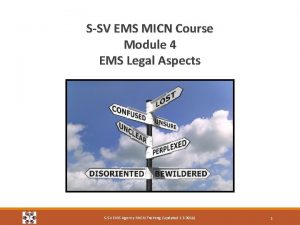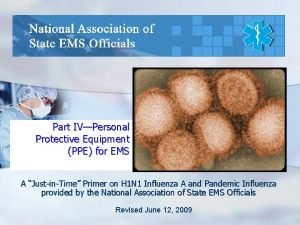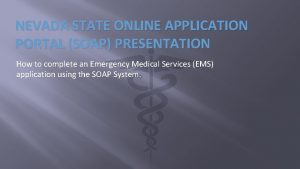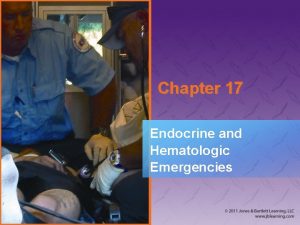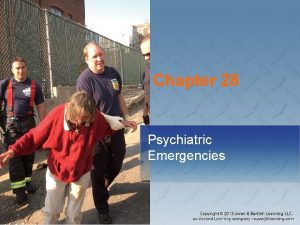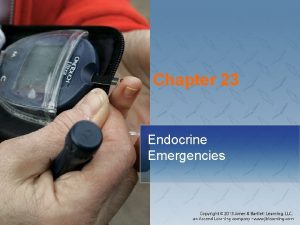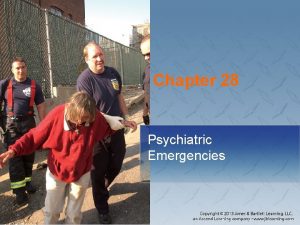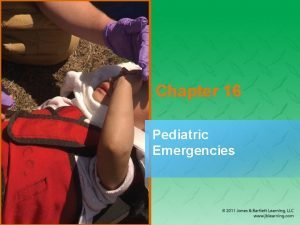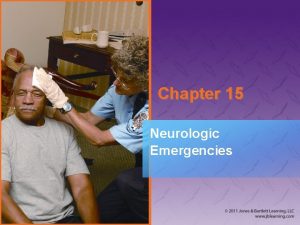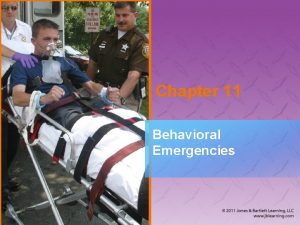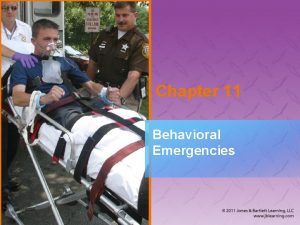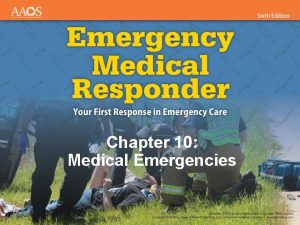Chapter 24 Hematologic Emergencies National EMS Education Standard
























































































- Slides: 88

Chapter 24 Hematologic Emergencies

National EMS Education Standard Competencies Medicine Integrates assessment findings with principles of epidemiology and pathophysiology to formulate a field impression and implement a comprehensive treatment/disposition plan for a patient with a medical complaint.

National EMS Education Standard Competencies Hematology • Anatomy, physiology, pathophysiology, assessment, and management of: − Sickle cell crisis − Clotting disorders

National EMS Education Standard Competencies • Anatomy, physiology, epidemiology, pathophysiology, psychosocial impact, presentations, prognosis, and management of common or major hematological diseases and/or emergencies − − Sickle cell crisis Blood transfusion complications Hemostatic disorders Lymphomas

National EMS Education Standard Competencies • Anatomy, physiology, epidemiology, pathophysiology, psychosocial impact, presentations, prognosis, and management of common or major hematological diseases and/or emergencies (cont’d) − Red blood cell disorders − White blood cell disorders − Coagulopathies

Introduction • EMS systems rarely respond to hematologic emergencies. • Hematologic disorder: any disorder of the blood − Hemolytic disorders − Hemostatic disorders

Introduction • Hematopoietic system − Organs and tissues involved in the production of blood components

Blood and Plasma • Blood performs the following functions: − Respiratory − Nutritional − Excretory − Regulatory − Defensive

Blood and Plasma • Blood is made of: − Plasma: • 92% water • 55% of total blood volume − Formed elements: • 45% of total blood volume • Includes RBCs, WBCs, and platelets

Blood and Plasma • The production of RBCs occurs within stem cells. − Stimulated by erythropoietin − Five days to mature • Average life span: 4 months − Hemoglobin carries oxygen to the tissues.

Blood and Plasma • Three common lab tests: − RBC count − Hemoglobin level − Hematocrit measurement

Blood and Plasma • White blood cells − Larger than RBCs − Immunity against “foreign invaders” − Derived from stem cells − Several types • Platelets − Smallest formed element − Clot the blood • Hemostasis − Two thirds circulate through the blood.

Blood-Forming Organs and RBC Production • The major players in the hematologic system are the: − Bone marrow − Liver − Spleen

The Inflammatory Process • All of the body’s cells and blood contain antigens at birth. − Antigens activate the immune system. • Autoimmune diseases − Identify the body’s own antigen as foreign

The Immune System • Processes protect against pathogens and other unwanted materials. − Must distinguish between: • Body’s own tissue • Outside organs

The Immune System • Native immunity − Nonspecific, maximal response − First line of defense − Associated with initial inflammatory response • Acquired immunity − Specific to vertebrates − A pathogenspecific response

The Immune System • Humoral immunity − Secretion of immunoglobins • Recognizes a specific antigen • Cell-mediated immunity − Macrophages and T-cells destroy pathogens.

The Immune System • White blood cells − Produced in the bone marrow − Laboratory values provide information on the immune system. − Baseline count is normally 5, 000– 10, 000 cells/µL.

The Immune System

Blood Classifications • Developed to prevent medical problems during replacement − ABO system

Blood Classifications • Blood contains a secondary antigen called the Rh antigen. − Possible complications in pregnancy • Hemolytic disease

Hemostasis • The process of stopping bleeding through: − Vasoconstriction (immediate response) − Platelet plugging − Coagulation • Clots are made up of fibrin.

Hemostasis • Clotting cascade − Can be initiated through: • Intrinsic pathway • Extrinsic pathway − Coagulopathy: process that interferes with the clotting cascade or hemostasis

Patient Assessment • Note any lifethreatening signs or symptoms. − Ask about patient’s history and SAMPLE history. − A nonjudgmental approach is essential.

Scene Size-Up • Ensure the scene is safe for entry. • Consider the mechanism of injury. • Determine the number of patients. • Assess for hazards.

Primary Assessment • An African American or Mediterranean patient reporting severe pain may have sickle cell disease. − Perform cervical spine stabilization if necessary.

Primary Assessment • Form a general impression. − Perform a rapid scan and determine LOC. • Airway and breathing − Inadequate breathing or altered mental status should receive high-flow oxygen or ventilation.

Primary Assessment • Circulation − Manage life-threatening conditions. − If hemophilia is suspected, watch for: • Acute blood loss • Bleeding of unknown origin • Hypoxia or shock

Primary Assessment • Transport decision − Depends on severity and patient’s wishes − Transport to the closest facility if: • Sickle cell crisis • Uncontrolled bleeding

History Taking • Obtain patient and SAMPLE history. • Do not take a sickle cell crisis lightly. − Life-threatening situations, characterized by: • Signs of pneumonia • Swelling of fingers and toes • Jaundice

History Taking • Look for: − − − Changes in LOC Vertigo Feelings of fatigue Syncope Dyspnea Chest pain − Changes in pulse rate and rhythm − Coughing up blood − Visual disturbances − Muscle pain − Stiffness

History Taking • Is pain isolated or felt throughout? • Has the patient experienced: − − − Skin changes? Bleeding? History of liver problems? Pain for unknown reasons? Genitourinary or gastrointestinal problems?

History Taking • If known sickle cell disease, ask: − − Have you had a crisis before? When was the last time? How did it resolve? Have you had any illness, unusual amount of activity, or stress lately?

Secondary Assessment • Performed on scene, en route, or not at all • Perform a physical exam, focusing on major joints. • Obtain vital signs.

Secondary Assessment • Evaluate and documental status. • In patients experiencing a sickle cell crisis: − Respirations are normal to rapid. − Pulse is weak and rapid. − Skin is pale and clammy with low blood pressure.

Reassessment • Reassess frequently. • Administer supplemental oxygen. • Provide ventilation as appropriate. • Cover to maintain body temperature.

Reassessment • According to local protocol, administer: − IV fluid − Nitrous oxide • Prehospital care for hemophilia can include IV therapy.

Reassessment • Inform hospital staff about: − Patient history − Present situation − Assessment findings − Interventions and their results • Document: − − Each assessment Your findings Treatment Time of interventions − Changes in patient condition

Emergency Medical Care • Emergency medical care should include: − − − Oxygen Fluids ECG Comfort Pharmacology Support

Sickle Cell Crisis • Pathophysiology − Leading inherited blood disorder − Gene defect of the adult-type hemoglobin (Hb. A) − Defective RBCs have an oblong shape. Courtesy of Bill Branson/National Cancer Institute

Sickle Cell Crisis • Pathophysiology (cont’d) − Can lead to: • Aplastic crisis: RBC production temporarily stops. • Hemolytic crisis: Acute RBC destruction

Sickle Cell Crisis • Pathophysiology (cont’d) − May manifest as: • Vaso-occlusive crisis • Acute chest syndrome • Splenic sequestration crisis

Sickle Cell Crisis • Assessment − Characterizations may include: • • Shortness of breath Inadequate perfusion of the skin Jaundice Mild dehydration

Sickle Cell Crisis • Assessment (cont’d) − Patients may have significant pain. • Pediatric patients typically present with pain in the hands and feet. • Adults typically report back and proximal extremity pain.

Sickle Cell Crisis • Management − − − Administer high levels of oxygen. Rapidly transport patient. Consider IV fluid therapy. Maintain patient’s body temperature. Recommend that patient rest.

Anemia • Pathophysiology − Low hemoglobin or erythrocyte level − Usually associated with an underlying disease

Anemia • Iron deficiency anemia − Most common type − Causes include: • Gastrointestinal blood loss • Menstrual bleeding • Frequent donations or diagnostic test

Anemia • Pathophysiology (cont’d) − May be caused by an inherited hemolytic disorder or a hematologic disorder − Can have serious consequences in high altitudes

Anemia • Assessment − Patients may feel: • • Worn down Lack of energy Overexerted Unable to “catch their breath” − Patients may have: • Anginal-type chest pain • Leukopenia • Thrombocytopenia

Anemia • Management − − Check and monitor airway breathing. Check vital signs frequently. For chest pain, apply a cardiac monitor. Blood pressure management and fluid replacement may be needed.

Anemia • Management (cont’d) − Allow the patient to rest. − Consider rapid transport for: • Abrupt change in consciousness • Hypotension • Significant perfusion inadequacies

Leukemia • Pathophysiology • Anemia • Thrombocytopenia • Leukocytosis Courtesy of Mark C. Ide − Cancer in the lymphoid system − Blood cells develop abnormally and/or excessively, causing:

Leukemia • Pathophysiology (cont’d) − Acute leukemia: Bone marrow is replaced with abnormal lymphoblasts − Chronic leukemia: Abnormal cells accumulate in: • • Bone marrow Lymph nodes Spleen Peripheral blood

Leukemia • Pathophysiology (cont’d) − Survival depends on several factors: • Stage of detection • Underlying medical condition • Response to treatment − Treated with chemotherapy and radiation

Leukemia • Assessment − Patient presentation depends on: • Stage of leukemia • Current treatment − Patients may present with: • • Fatigue Headaches Bone pain Unexplained bleeding

Leukemia • Management − As appropriate, provide: • • • Airway support Oxygen therapy IV fluid therapy Analgesics Positive support

Leukemia • Management (cont’d) − You may be called because loved ones are uncertain about what to do. • Discuss with medical control. • Document all findings. • Have a refusal/release form signed.

Lymphomas • Pathophysiology − Group of malignant diseases within the lymphoid system − Classified in two categories

Lymphomas • Non-Hodgkin − Any age − Can be hereditary − Characterized by progression • Indolent • Aggressive • Highly aggressive • Hodgkin: − Progressive enlargement of lymphoid glands − Highly rare − Peaks between: • 15– 35 years of age • After age 55– 60

Lymphomas • Assessment − Require chemotherapy or radiation. − Signs and symptoms may include: • • Pallor Feeling hot and then cold or both Inadequate perfusion Abnormal ECG rhythms

Lymphomas • Management − Aggressive pain management − Treat inadequate perfusion and abnormal heart rhythms. − Initiate rapid transport if condition does not improve.

Polycythemia • Pathophysiology − − Overabundance or overproduction of RBCs Multiple causes Can lead to other conditions Treatment usually includes phlebotomy or cancer-type therapy

Polycythemia • Assessment − Findings may widely vary − Note the extent and duration of dyspnea. − Has the patient experienced pruritus or changes in skin temperature?

Polycythemia • Management − Consists of supportive care and transport to the appropriate facility. − Administer oxygen and establish IV as needed.

Disseminated Intravascular Coagulation • Pathophysiology − Number of causes − Two stages: • Defibrination • Uncontrolled hemorrhage − High mortality rate

Disseminated Intravascular Coagulation • Assessment − Identify associated signs and symptoms. − Patients may have: • Respiratory difficulty • Signs of shock • Skin changes

Disseminated Intravascular Coagulation • Management − Identify underlying cause and establish treatment early. − Maintain an airway. − Treat for shock.

Hemophilia • Pathophysiology − A bleeding disorder in which clotting: • Does not occur • Occurs insufficiently − Two primary types: A and B

Hemophilia • Pathophysiology (cont’d) − Signs and symptoms may include: • Acute and chronic bleeding − Patients may require: • Hospitalization for transfusion • Infusion of factors VIII and IX

Hemophilia • Assessment − − Take care of the ABCs. Be alert for signs of acute blood loss. Note any bleeding of unknown origin. Patients may show signs of hypoxia.

Hemophilia • Management − − Patients may need high-flow oxygen. Note ECG findings. IV therapy may be necessary. Analgesics may be appropriate.

Multiple Myeloma • Pathophysiology − Number of plasma cells in the bone marrow increase abnormally • Forms tumors in the bone • Results in anemia and susceptibility to infection

Multiple Myeloma • Pathophysiology (cont’d) − Neoplastic cells may accelerate protein development in the bloodstream. − Patients may have weakness in the bones. − Chemotherapy and other anticancer treatment may be given.

Multiple Myeloma • Assessment − Findings depend on stage − Early stage: • Fatigue • Mild pain − Later stage: • • Hemorrhage Weight loss Bone fractures Pain

Multiple Myeloma • Management: − IV therapy − Pain management − Supportive care

Transfusion Reactions • Pathophysiology − Similar to anaphylactic reaction − Monitor a patient receiving a blood transfusion very closely for the first 30– 60 minutes − Occurs when a patient receives a blood type different than their own

Transfusion Reactions • Assessment − Symptoms can be subtle in patients who are unresponsive or intubated. − An acute reaction may include a rapid onset of: • Chills • Back pain • Hypotension

Transfusion Reactions • Assessment (cont’d) − Complications include: • • • Hemolytic Febrile Allergic Transfusion-related lung injury Circulatory overload Bacterial infection

Transfusion Reactions • Management − Immediately stop the transfusion. − Provide hemodynamic supportive care. − Maximize kidney perfusion.

Transfusion Reactions • Management (cont’d) − A hemodynamically unstable patient requires: • Early invasive monitoring • Vasopressors • Promotion of diuresis − Administer high-flow oxygen.

Summary • Most EMS systems rarely respond to hematologic emergencies. • Blood performs respiratory, nutritional, excretory, regulatory, and defensive functions. • Blood is made up of plasma and formed elements, including RBCs, WBCs, and platelets.

Summary • Common lab blood tests are RBC count, hemoglobin level, and hematocrit measurement. • Blood tests measuring subtypes of WBCs can provide valuable information about the status of the immune system. • The ABO system is commonly used to classify blood types.

Summary • During the primary assessment, note any signs and symptoms that may be immediately life threatening. • While taking a history and during the secondary assessment, look for changes in the level of consciousness. • General blood disorder management should include oxygen, fluids, ECG, transport, medications, and psychological support.

Summary • Hematologic disorders include sickle cell crisis, anemia, leucopenia, thrombocytopenia, leukemia, lymphomas, polycythemia, DIC, hemophilia, multiple myeloma, and complications of blood transfusions.

Summary • A patient experiencing a sickle cell crisis will experience significant pain. • A patient with anemia has a low hemoglobin or RBC level. • Leukopenia is a reduction in the number of WBCs. Thrombocytopenia is a reduction in the number of platelets. • Leukemia is a cancer that affects the production of WBCs.

Summary • Lymphomas are a group of malignant disorders that occur within the lymphoid system. The two types are non-Hodgkin (most common) and Hodgkin lymphoma. • Polycythemia is an overabundance or overproduction of RBCs. • Disseminated intravascular coagulation (DIC) may result from a massive injury, sepsis, or obstetric complications.

Summary • Hemophilia is a bleeding disorder in which clotting does not happen or is insufficient. • Multiple myeloma is a cancer of the bone marrow caused by malignant plasma cells. • Complications of blood transfusions are similar to anaphylactic reactions. They are caused by a mismatch of the patient’s blood type to that received, or an allergic reaction to preservatives or agents in the transfused product.

Credits • Chapter opener: © Monkey Business Images/Shutter. Stock, Inc. • Backgrounds: Orange—© Keith Brofsky/ Photodisc/Getty Images; Blue—Courtesy of Rhonda Beck; Lime—© Photodisc; Purple— Courtesy of Rhonda Beck. • Unless otherwise indicated, all photographs and illustrations are under copyright of Jones & Bartlett Learning, courtesy of Maryland Institute for Emergency Medical Services Systems, or have been provided by the American Academy of Orthopaedic Surgeons.
 Chapter 19 endocrine and hematologic emergencies
Chapter 19 endocrine and hematologic emergencies National ems standards
National ems standards Assessment of hematologic system
Assessment of hematologic system Hematologic system definition
Hematologic system definition Hematologic system assessment
Hematologic system assessment Chapter 16 respiratory emergencies
Chapter 16 respiratory emergencies Environmental emergencies emt
Environmental emergencies emt Chapter 23 gynecologic emergencies
Chapter 23 gynecologic emergencies The term behavioral crisis is most accurately defined as
The term behavioral crisis is most accurately defined as Chapter 18 neurologic emergencies
Chapter 18 neurologic emergencies Emt chapter 18 gastrointestinal and urologic emergencies
Emt chapter 18 gastrointestinal and urologic emergencies Chapter 28 lesson 1
Chapter 28 lesson 1 Chapter 16 respiratory emergencies
Chapter 16 respiratory emergencies Gems diamond geriatric assessment
Gems diamond geriatric assessment Chapter 13 handling emergencies
Chapter 13 handling emergencies Chapter 12 behavioral emergencies
Chapter 12 behavioral emergencies Chapter 32 environmental emergencies
Chapter 32 environmental emergencies Chapter 17 cardiovascular emergencies
Chapter 17 cardiovascular emergencies Chapter 17 neurologic emergencies
Chapter 17 neurologic emergencies National ems advisory council
National ems advisory council Padi quiz 1 answers
Padi quiz 1 answers Major nutritional deficiency diseases in emergencies
Major nutritional deficiency diseases in emergencies Lesson 6: cardiac emergencies and using an aed
Lesson 6: cardiac emergencies and using an aed Lsu hematology oncology
Lsu hematology oncology Psychiatric emergencies
Psychiatric emergencies Qut security emergency extension number
Qut security emergency extension number Immunologic emergencies
Immunologic emergencies Ems system components
Ems system components Ems systems chapter 1
Ems systems chapter 1 Standard error of the mean
Standard error of the mean What is a standard language
What is a standard language Standard costing
Standard costing Bahagian kurikulum sekolah
Bahagian kurikulum sekolah Six priorities of department of health
Six priorities of department of health Nqs assessment
Nqs assessment Dsmith
Dsmith National standard 1
National standard 1 Nfpa 1600 standard
Nfpa 1600 standard Nsmc chart
Nsmc chart Labelled
Labelled National healthy housing standard
National healthy housing standard Nfpa 1600 business continuity programs
Nfpa 1600 business continuity programs National standard practice manual
National standard practice manual National unification and the national state
National unification and the national state Classification of education
Classification of education Career education standards 3-18
Career education standards 3-18 National forum on education statistics
National forum on education statistics National education blueprint
National education blueprint Trgpol
Trgpol National education foundation nef
National education foundation nef National council for special education
National council for special education National consortium of interpreter education centers
National consortium of interpreter education centers Symbols in fahrenheit 451
Symbols in fahrenheit 451 Early national period education
Early national period education National forum on education statistics
National forum on education statistics Social factors pe nat 5
Social factors pe nat 5 Ministry of education morocco
Ministry of education morocco National education policy 1998
National education policy 1998 Uae national agenda for schools
Uae national agenda for schools National research and education network
National research and education network National computing council
National computing council National forum on education statistics
National forum on education statistics National research center for career and technical education
National research center for career and technical education National science education standards inquiry
National science education standards inquiry National higher education strategic plan
National higher education strategic plan National association of special education teachers
National association of special education teachers National forum on education statistics
National forum on education statistics Objectives of kothari commission
Objectives of kothari commission Ffa creed
Ffa creed National business education standards
National business education standards National forum on education statistics
National forum on education statistics National core curriculum for basic education 2014
National core curriculum for basic education 2014 National board of education finland
National board of education finland Policies of inclusive education ppt
Policies of inclusive education ppt Brownfield ap human geography definition
Brownfield ap human geography definition Ministry of national education romania
Ministry of national education romania National council for economic education
National council for economic education Wi ems wards
Wi ems wards Deferred payment plan uc merced
Deferred payment plan uc merced Ems felvételre kijelölt posták
Ems felvételre kijelölt posták Verdant ems
Verdant ems Ssvems
Ssvems Ems equipment repair
Ems equipment repair Southwest virginia ems council
Southwest virginia ems council Ems latlit
Ems latlit How to write an ems narrative
How to write an ems narrative Nbitrex
Nbitrex Nevada ems soap
Nevada ems soap Iso 9001 environmental management system
Iso 9001 environmental management system

